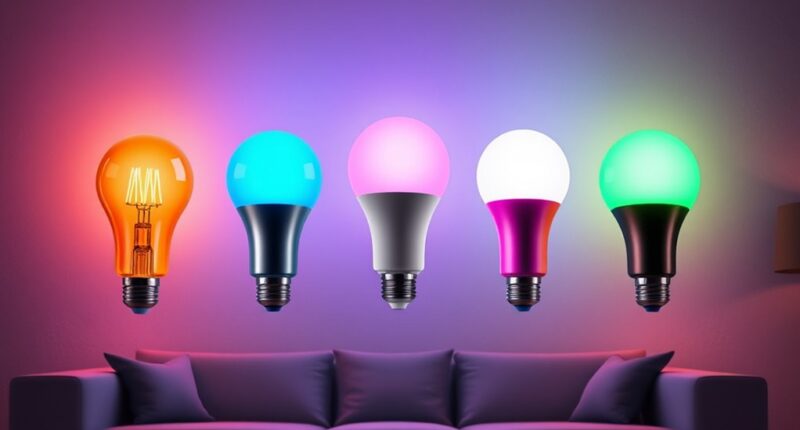If you’re looking to upgrade your home lighting in 2025, I recommend checking out the top five smart bulbs that offer great features at different price points. From budget-friendly options like the Amazon Basics and Linkind packs to versatile color-changing bulbs from Govee and Kasa, these choices provide customizable brightness, colors, and easy app or voice control. Keep reading to discover which smart bulb is perfect for your needs and how to get the most out of your smart lighting setup.
Key Takeaways
- Top smart bulbs of 2025 offer seamless Wi-Fi or Bluetooth control, enabling easy customization without hubs.
- They support millions of colors, adjustable brightness, and white temperature settings for personalized ambiance.
- Budget-friendly options like Amazon Basics and Linkind provide reliable performance and energy efficiency.
- Installation is quick and straightforward, ideal for users with minimal technical skills seeking smart home upgrades.
- Compatibility with voice assistants (Alexa, Google) and app features like scheduling enhance user convenience.
Amazon Basics Smart Indoor LED Light Bulb, Tunable White
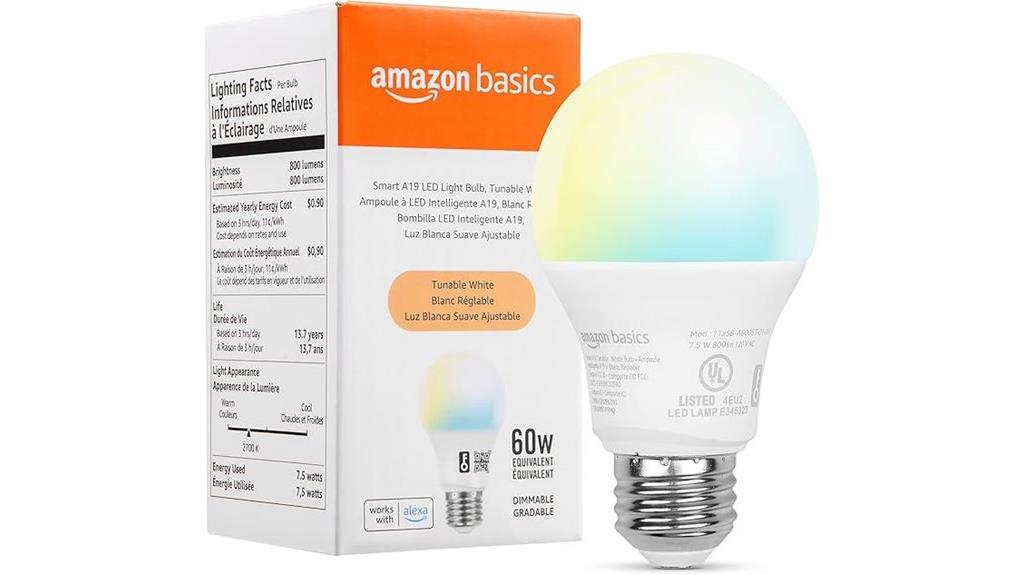
If you’re looking for an affordable and easy-to-use smart bulb for your indoor space, the Amazon Basics Smart Indoor LED Light Bulb with tunable white is a great choice. It connects directly via Wi-Fi, works with Alexa, and requires no hub. You can adjust brightness from 5% to 100% and tune the white light from warm to cool (2200K-6500K). The 800-lumen bulb is energy-efficient, consuming just 7.5W. Installation is simple—screw it in, and connect through the Alexa app. While some users face connectivity issues, upgrading Wi-Fi can help. Overall, it’s a budget-friendly option with versatile lighting and voice control.
Best For: Budget-conscious homeowners seeking easy, voice-controlled smart lighting for indoor spaces without the need for a hub.
Pros:
- Easy installation and setup via Wi-Fi with no hub required
- Compatible with Alexa for seamless voice control and routines
- Adjustable brightness and tunable white light for customizable ambiance
Cons:
- Occasional connectivity issues, especially during initial setup
- Slightly less bright than premium smart bulbs like Philips Hue
- Limited customer support and potential troubleshooting challenges
Linkind Smart Light Bulbs, 4-Pack
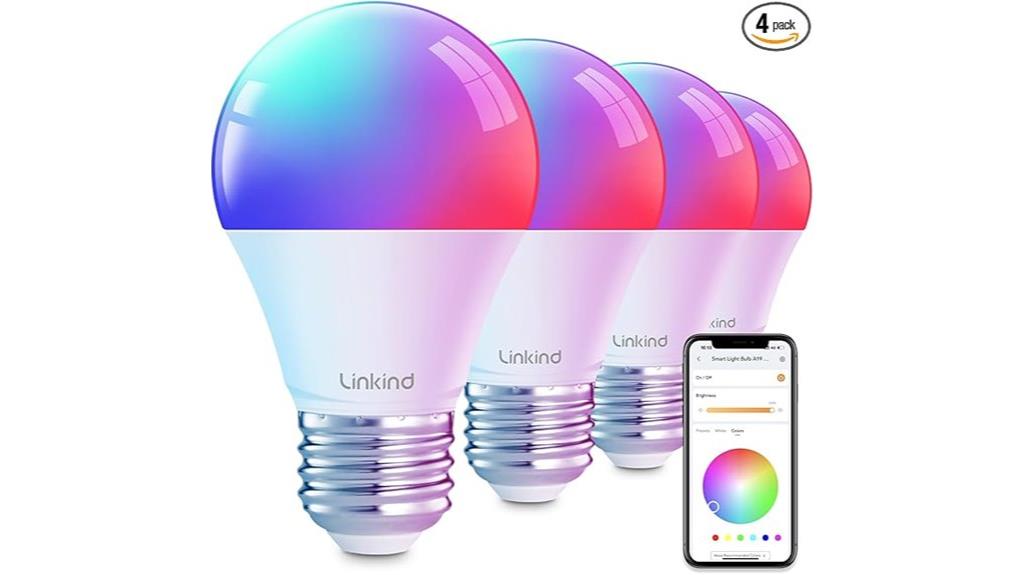
The Linkind Smart Light Bulbs, 4-Pack, stand out as an ideal choice for anyone seeking vibrant, customizable indoor lighting with easy voice control. These LED bulbs mimic 60W incandescent brightness, offering 800 lumens and a wide color temperature range from warm to cool white. With support for 16 million colors, preset scenes, and music sync, they create dynamic atmospheres for any occasion. Compatible with Alexa and Google Assistant, you can control them via voice or the AiDot app. Easy to install and energy-efficient, these bulbs are designed for indoor use and offer a lifespan of about 25,000 hours, making them a versatile and durable lighting upgrade.
Best For: those seeking customizable, vibrant indoor lighting with easy voice control for enhancing home ambiance and mood settings.
Pros:
- Supports 16 million colors and preset scenes for versatile lighting options
- Compatible with Alexa and Google Assistant for convenient voice control
- Energy-efficient LED design with a long lifespan of approximately 25,000 hours
Cons:
- Connectivity issues reported, especially with Alexa integration for some users
- Some bulbs may arrive defective or experience troubleshooting challenges
- Requires 2.4GHz WiFi and Bluetooth, which may limit compatibility with certain networks
Kasa Smart Color Changing WiFi Light Bulbs (4 Pack)
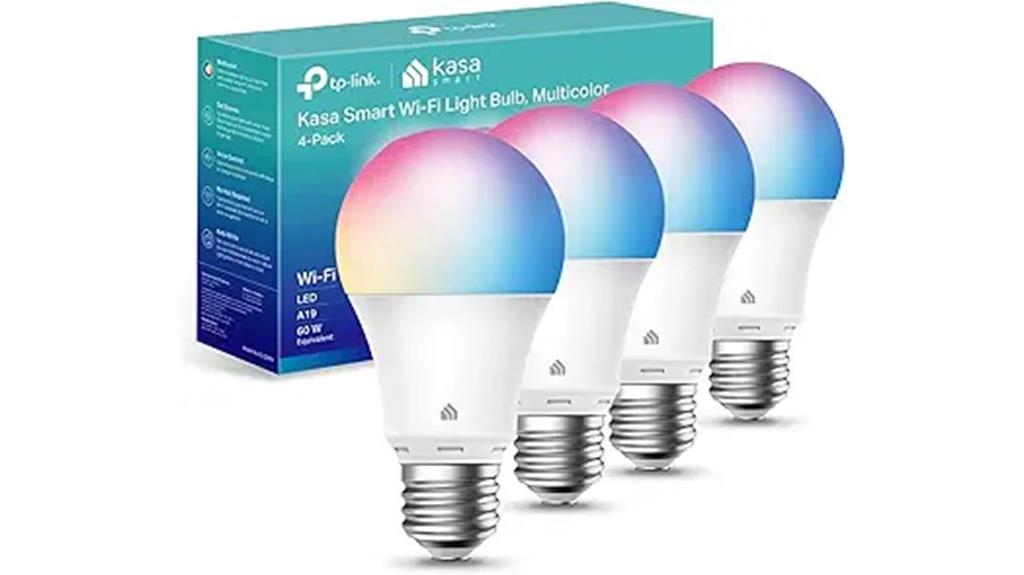
Kasa Smart Color Changing WiFi Light Bulbs (4 Pack) stand out as an ideal choice for homeowners who want customizable lighting without the hassle of hubs or complicated setups. These bulbs are full color-changing, dimmable, and compatible with Alexa and Google Assistant, making control effortless. With support for 16 million colors and adjustable white temperature, I can easily set the perfect mood for any occasion. The bulbs operate on 2.4GHz Wi-Fi, so no hub is needed. I love using the Kasa app for remote control, scheduling, and automation. Plus, they’re energy-efficient, reducing power consumption and providing real-time usage monitoring.
Best For: homeowners seeking customizable, easy-to-control lighting solutions that integrate seamlessly with smart home systems without the need for hubs.
Pros:
- Supports 16 million colors and adjustable white temperature for versatile lighting moods
- No hub required; operates directly over 2.4GHz Wi-Fi for simple setup
- Compatible with Alexa and Google Assistant for voice control and remote management
Cons:
- Limited to 2.4GHz Wi-Fi networks, which may cause connectivity issues in crowded environments
- Requires the Kasa app for full functionality, which may not be preferred by all users
- Only suitable for indoor use within specified humidity and temperature ranges
Linkind Smart Light Bulbs, 1600LM (100W Equivalent) 4-Pack

Linkind Smart Light Bulbs are an excellent choice for anyone seeking bright, energy-efficient lighting that can be easily controlled through voice commands or smartphone apps. With 1600 lumens, these bulbs match the brightness of 100W incandescent bulbs but only use 14W, saving energy while illuminating large spaces. They work seamlessly with Alexa and Google Home, allowing you to turn lights on or off, adjust brightness, and change color temperature hands-free. The 16 million color options and tunable whites let you set the perfect mood. Plus, dual Wi-Fi and Bluetooth connectivity guarantee quick, reliable control, making them a versatile addition to any smart home.
Best For: homeowners and tech enthusiasts seeking customizable, energy-efficient smart lighting controlled via voice or smartphone apps.
Pros:
- Bright 1600 lumens output with energy-efficient 14W consumption
- Compatibility with Alexa and Google Home for hands-free control
- Rich color options with 16 million hues and tunable white for versatile ambiance
Cons:
- Only supports 2.4GHz Wi-Fi, not compatible with 5GHz networks
- Requires both Wi-Fi and Bluetooth for initial setup, which may be complex for some users
- Microphone permission needed for music sync features, raising privacy considerations
Govee Smart Light Bulbs, Color Changing RGBWW A19 (4 Pack)
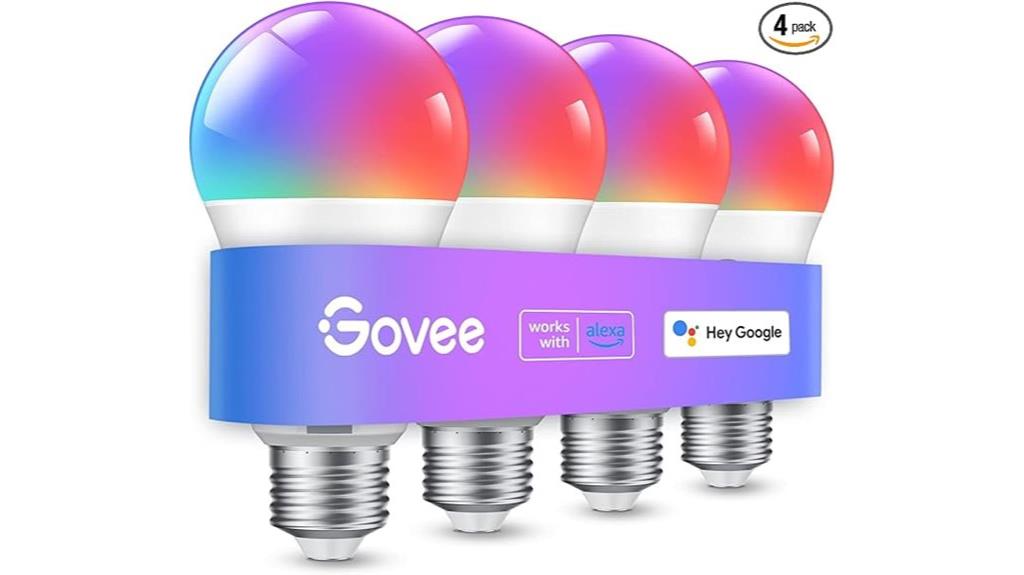
If you’re looking for versatile, customizable lighting that’s easy to control, Govee’s 4-pack of Color Changing RGBWW A19 bulbs is an excellent choice. These bulbs offer 16 million colors, 54 preset scene modes, and white brightness up to 800 lumens. They connect seamlessly via Wi-Fi and Bluetooth, compatible with Alexa and Google Assistant, with no hub needed. The app allows for easy setup, scene customization, and group control. Features like music sync, timers, and schedules make them perfect for mood lighting, parties, or daily use. With a durable build and high user ratings, these bulbs deliver vibrant, reliable lighting at a competitive price.
Best For: homeowners and renters seeking customizable, easy-to-use smart lighting for mood enhancement, entertainment, and daily illumination.
Pros:
- Bright, vibrant colors with accurate RGB display and white brightness up to 800 lumens
- Easy setup via app with seamless Wi-Fi and Bluetooth connectivity, no hub required
- Supports voice control through Alexa and Google Assistant, plus features like music sync and scheduling
Cons:
- Limited to 2.4GHz Wi-Fi, not compatible with 5G networks
- Slight variation in brightness levels, possibly due to lamp wattage
- Some users may experience initial connectivity or app compatibility issues
Factors to Consider When Choosing Smart Light Bulbs
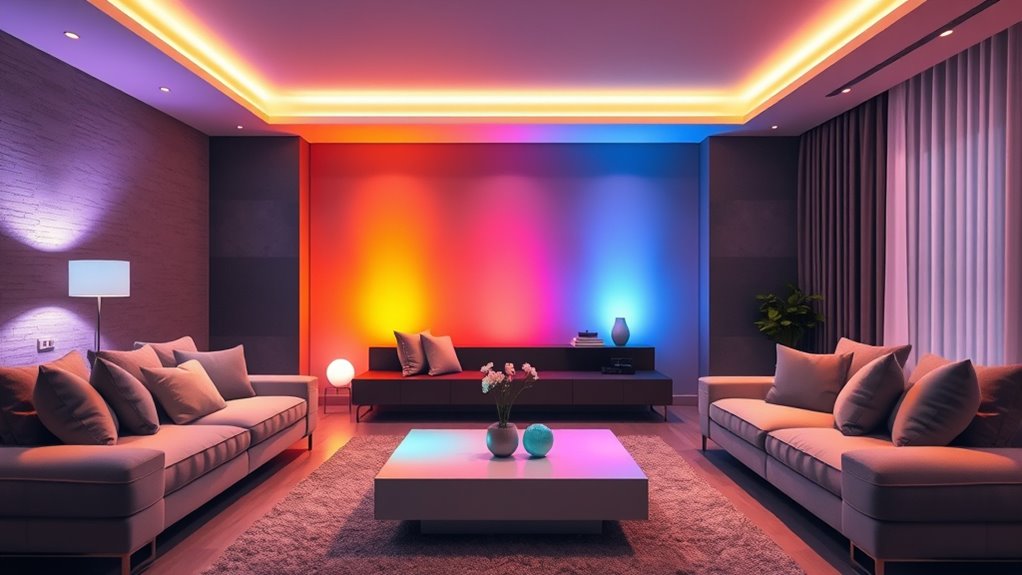
When choosing smart light bulbs, I look at how well they work with my existing devices, like my smart speaker or hub. Brightness levels and color options matter, as does how easy it is to connect and set up the bulbs. I also consider how customizable they are and whether they offer different ways to control them for the best experience.
Compatibility With Devices
Choosing the right smart light bulb starts with making certain it’s compatible with your existing devices and ecosystem. I always check if the bulb works with my voice assistants like Alexa, Google Assistant, or Apple HomeKit to avoid integration issues. It’s also important to verify whether the bulb supports my Wi-Fi network’s frequency—whether 2.4GHz or 5GHz—to ensure a stable connection. I look at the app and voice control options to confirm they match my preferred setup. Additionally, I check the communication protocol—Wi-Fi, Bluetooth, Zigbee, or Z-Wave—to make sure it aligns with my smart home hub. In conclusion, I read product specs to see if features like color changing, dimming, or scheduling are supported by my current devices, so everything works seamlessly together.
Brightness and Color Range
Have you ever wondered how the brightness and color options of a smart bulb can transform your space? Brightness, measured in lumens, determines how much light a bulb emits—most indoor smart bulbs offer around 800 lumens, enough for typical rooms. Color range varies widely; many support millions of colors or adjustable white temperatures from warm (around 1800K) to cool (up to 6500K). Warmer tones create cozy atmospheres, while cooler whites are great for task lighting. Some bulbs include preset scene modes to set specific moods instantly. Adjustable brightness levels let you fine-tune lighting from as low as 5% to full brightness, giving you control over ambiance and functionality. This versatility makes selecting a bulb that matches your needs essential for transforming your home.
Connectivity Methods
Selecting the right connectivity method for your smart light bulbs is essential because it influences how reliably and easily you can control your lighting. Wi-Fi-connected bulbs let you control them directly through your home network, offering remote access from anywhere with an internet connection. This makes managing your lights convenient, especially when you’re away. Bluetooth bulbs, on the other hand, typically require close proximity and are best for localized control, often needing a compatible app on your phone. Zigbee and Z-Wave bulbs operate on dedicated mesh networks, requiring a hub or bridge but providing enhanced stability and better integration with other smart devices. Your choice impacts setup complexity, control reliability, and compatibility with your existing smart home ecosystem. Consider your needs and existing devices when selecting the best connectivity method.
Ease of Installation
Installing smart light bulbs is generally a simple process that most people can complete in just a few minutes. Usually, you just screw the bulb into a standard socket, which is straightforward and familiar. Connecting it to your Wi-Fi or Bluetooth typically involves using a mobile app or voice assistant, and most bulbs support these with minimal fuss. The setup usually takes less than 10 minutes, making it accessible even if you’re not tech-savvy. Clear instructions and minimal extra hardware, like hubs, help streamline the process. Compatibility with standard fixtures and user-friendly app interfaces further reduce hassle. Overall, the ease of installation makes smart bulbs an appealing upgrade for anyone looking to enhance their home lighting without complicated setups.
Customization Options
When choosing smart light bulbs, considering their customization options is essential to tailor your lighting experience to your needs. Look for bulbs that offer a wide range of colors and adjustable white light temperatures to create the perfect ambiance. Preset scene modes and automation features like schedules or timers help you craft personalized lighting routines effortlessly. App-based controls are also valuable, allowing you to adjust brightness, color, and effects directly from your smartphone. Make sure the interface is user-friendly so you can easily create scenes without hassle. Finally, verify compatibility with your existing smart home system to ensure seamless integration. These features help you customize your lighting to suit any mood or occasion, making your smart bulbs truly adaptable.
Energy Efficiency
Energy efficiency is an important factor to contemplate alongside customization options when choosing smart light bulbs. These bulbs typically consume between 5W and 14W, offering significant savings compared to traditional incandescent bulbs that use 60W or more. Many are dimmable, allowing you to lower brightness levels and reduce power consumption further. Look for smart bulbs with Energy Star certification or similar ratings, which guarantee low energy use and adherence to efficiency standards. Scheduling or automating lighting helps prevent unnecessary usage, cutting down on electricity bills and environmental impact. Additionally, smart bulbs boast a long lifespan, often exceeding 25,000 hours, meaning fewer replacements and less waste. Prioritizing energy efficiency ensures your lighting is environmentally friendly and cost-effective over time.
Price and Warranty
Price and warranty are key factors to contemplate because they directly impact your investment and peace of mind. Smart light bulbs range from about $10 for basic models to over $50 for premium options, so your budget guides your choices. Most come with a standard 30-day return policy, but some brands offer extended warranties of 1 to 3 years, providing extra security against defects or failures. Longer warranties are especially valuable for higher-priced or complex lighting systems. Keep in mind that budget-friendly bulbs may have limited or no warranties, so it’s important to review manufacturer support policies before buying. Understanding what’s covered—whether replacement, repair, or technical support—helps ensure you’re making a smart, informed investment in your home lighting.
Frequently Asked Questions
How Do Smart Bulbs Integrate With Existing Home Automation Systems?
The current question about smart bulbs integrating with home automation systems is really important. I’ve found that most smart bulbs connect easily through Wi-Fi or Zigbee and work with popular platforms like Alexa, Google Home, or Apple HomeKit. I just make sure my bulbs are compatible, then use a hub or app to sync everything. It’s simple to control my lighting remotely and create custom schedules.
What Is the Typical Lifespan of the Best Smart Light Bulbs?
The typical lifespan of the best smart light bulbs usually ranges from 15,000 to 25,000 hours, depending on the brand and usage. I’ve found that high-quality bulbs tend to last longer, saving me money and hassle. I recommend checking the manufacturer’s specs for exact longevity. Overall, smart bulbs are a reliable investment, offering years of energy-efficient, smart lighting before needing a replacement.
Are Smart Bulbs Energy-Efficient Compared to Traditional Bulbs?
Smart bulbs are definitely more energy-efficient than traditional incandescent bulbs. They use LED technology, which consumes less power and lasts longer, saving you money over time. Plus, you can control brightness and schedule usage, reducing unnecessary energy waste. I’ve found that switching to smart bulbs helps me cut my energy bills while enjoying customizable lighting. Overall, they’re a smarter, greener choice for home lighting.
Can Smart Bulbs Be Used Outdoors or in Damp Locations?
You’re wondering if smart bulbs can handle outdoor or damp areas. I’ve found that many smart bulbs are specifically designed for outdoor use and are weather-resistant, so they hold up well outside. Just make sure to check the product specifications for waterproof or damp-rated labels. I always choose bulbs with proper ratings to guarantee safety and durability, especially when installing them in areas exposed to moisture or outdoor elements.
How Secure Are Smart Light Bulbs Against Hacking Threats?
Think of smart bulbs like tiny digital guards—they can be secure, but vulnerabilities exist. I once heard about a home where hackers gained control of smart devices, highlighting risks. Most smart bulbs use encryption and regular updates to protect against hacking, but poor Wi-Fi security can still be a weakness. To stay safe, I recommend strong passwords and keeping firmware current. It’s about being vigilant, just like locking doors to keep intruders out.
Conclusion
Choosing the right smart light bulb is like finding the perfect tune for your home’s vibe. Whether you want tunable whites or vibrant colors, there’s a bulb out there that can turn your space into a personalized haven. Think of these options as the brushstrokes of your decorating masterpiece. With the right choice, your home lighting will not just illuminate but truly come alive, making every moment brighter and more beautiful.

